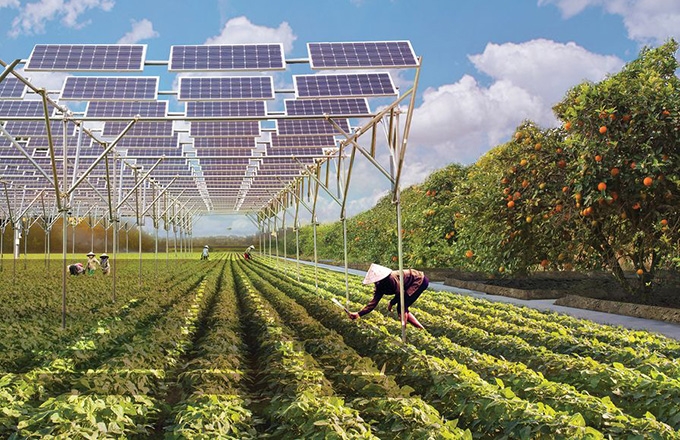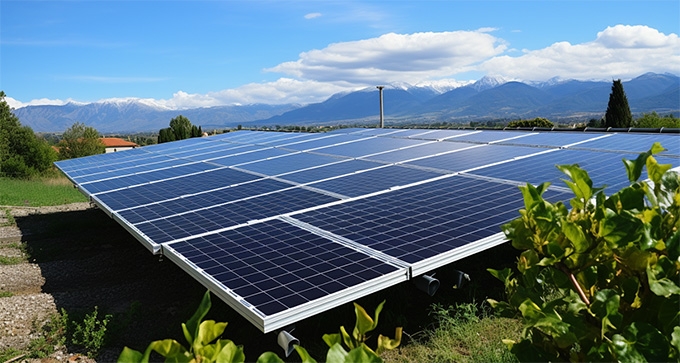As the global population is projected to reach 11 billion by the middle of the century, one of humanity's greatest challenges is meeting the dual demands of food and energy. This increasing demand has made the land a critical resource for agricultural production or clean energy development. Against this backdrop, agrivoltaics technology (Agri-Photovoltaics, APV) is emerging as a promising solution, transforming the competitive relationship between these needs into one of collaboration. By enabling both photovoltaic (PV) power generation and agricultural production on the same land, APV turns competition into synergy.
Since the early 2000s, agrivoltaics has provided a new model of electricity production, creating opportunities for mutual coexistence between agriculture and energy production. Also known as agri-PV, this technology combines PV power generation with agricultural activities by elevating solar panels above farmland or interspersing crops between PV rows. Agrivoltaics encompasses renewable energy, sustainable land use, and biodiversity conservation. It offers an innovative approach where solar power generation and agricultural practices coexist, fostering shared value creation for local communities.

Global Development of Agrivoltaics
According to data from the Inverter Online Store, agrivoltaics has seen significant deployment since its first projects. From 2004 to 2017, Japan established over 1,000 agrivoltaics power plants. This practice subsequently spread to other parts of Asia, particularly China, where agrivoltaics is used to combat desertification.
In Europe, PV greenhouses became pilot projects in the early 21st century, with open-field PV systems gaining traction. In the United States, agrivoltaics has rapidly developed with support from the Department of Energy. Although France lacks clear legal or regulatory definitions for agrivoltaics, its potential land area of 16 million hectares provides vast opportunities for its adoption.
Advantages and Challenges of Agrivoltaics
Agrivoltaics has the advantage of combining PV power generation with agricultural production to improve overall efficiency. However, the deployment of this technology faces several challenges.
- First, Agrivoltaics requires a significant investment of capital and time to build the infrastructure.
- Second, although Agrivoltaics can increase the overall productivity of the land, crop yields may decline slightly due to reduced light. Therefore, Agrivoltaics must be developed in a way that ensures that agricultural production is not affected.
- In addition, the production pattern of Agrivoltaics systems is very different from that of conventional PV installations, and parameters such as panel tilt angle, orientation, and slope need to be optimized to maximize power production.
Two Economic Models of Agrivoltaics
Elevated Agrivoltaics: Solar panels are installed on steel structures 2–6 meters high, allowing unrestricted use of agricultural machinery and crop planting. This model is particularly suited for high-value crops like grapes, berries, and fruit trees. By integrating solar-powered irrigation systems like solar water pumps, this approach enhances agricultural efficiency. Solar water pumps use PV-generated electricity to provide reliable irrigation, saving energy and reducing environmental impact. Economically, PV panels can replace protective nets or waterproof coverings, reducing maintenance costs despite the high initial investment.
Inter-row Agrivoltaics: This system involves low-mounted PV panels with rows spaced to accommodate low-value crops or fodder production. A "low-cost" alternative incorporates trackers that follow the sun's path, enabling power generation even at midday. Tracker-based systems are widely adopted, with hundreds of gigawatts installed globally, offering increasingly affordable options.
Indirect Benefits of Solar PV Panels for Agriculture
Regardless of which photovoltaic technology is used, the electricity produced by an Agrivoltaics power station is more valuable when used for its use because it directly reduces external power purchases. Although technological solutions are diverse, some crops are more suitable for agrivoltaics than others. Viticulture, orchards, and vegetable crops probably have the greatest potential for synergies. However, there appears to be no consensus on a standardized system to experimentally compare crop productivity under field conditions.
Despite clear progress in increasing solar panel productivity, the main arguments supporting the development of Agrivoltaics mainly emphasize the indirect advantages of modules. It is noted that some progress has been made in the dynamic protection of plantations, as PV panels directly protect the plants from environmental influences (rain, hail, wind). In addition to reducing the use of crop protection films, photovoltaic panels can in some cases prevent photosynthetic saturation of plants. Finally, depending on the form of the project, agrivoltaics systems are expected to significantly reduce crop irrigation needs by slowing the evaporation of water from the ground and harvesting rainwater.
The presence of ground vegetation can increase the yield of photovoltaic panels, as the latter limits the "heat island" effect by conventionally cooling the panels. This Agrivoltaics way of thinking, based on the pre-existing solar fields favoring solar production while growing low-growing vegetation, emphasizes biodiversity by planting flowers for pollinators in the photovoltaic park.

Challenges to Large-Scale Deployment
Despite the undeniable advantages of agricultural photovoltaic technology, large-scale deployment in this field has been slow due to many difficulties that have yet to be overcome.
- Operational Complexity: The complexity of the Agrivoltaics business model is generally greater than that of ground photovoltaic projects. Project implementation usually involves multiple stakeholders: land suppliers, agricultural managers, photovoltaic system developers (owners or investors), and their operators. Centralizing Agrivoltaics functions within a single entity will improve flexibility and adaptability.
- Insufficient Economic Incentives: In addition to the prospect of self-use, Agrivoltaics can also benefit greatly from easier access to the grid for producers. Currently, it is only possible to receive EEG remuneration when agricultural photovoltaic power plants are built in areas along highways or railways. For power plants with a rated power greater than 750 kW, they must also participate in the bidding, and self-use is not allowed.
Conclusion: A Path Toward Sustainable Development
Agrivoltaics represents a promising solution for integrating clean energy and food production, addressing climate change and resource challenges. However, its full potential requires further policy support, technological advancements (including improvement of solar inverter efficiency), and optimized economic models. In the race to revolutionize land use and energy systems, the synergy between solar energy and agriculture can lead the way toward a more sustainable future.
